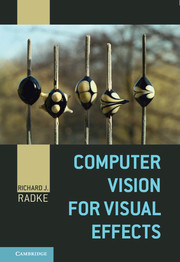Book contents
2 - Image Matting
Published online by Cambridge University Press: 05 December 2012
Summary
Separating a foreground element of an image from its background for later compositing into a new scene is one of the most basic and common tasks in visual effects production. This problem is typically called matting or pulling a matte when applied to film, or keying when applied to video. At its humblest level, local news stations insert weather maps behind meteorologists who are in fact standing in front of a green screen. At its most difficult, an actor with curly or wispy hair filmed in a complex real-world environment may need to be digitally removed from every frame of a long sequence.
Image matting is probably the oldest visual effects problem in filmmaking, and the search for a reliable automatic matting system has been ongoing since the early 1900s [393]. In fact, the main goal of Lucasfilm's original Computer Division (part of which later spun off to become Pixar) was to create a general-purpose image processing computer that natively understood mattes and facilitated complex compositing [375]. A major research milestone was a family of effective techniques for matting against a blue background developed in the Hollywood effects industry throughout the 1960s and 1970s. Such techniques have matured to the point that blue- and green-screen matting is involved in almost every mass-market TV show or movie, even hospital shows and period dramas.
On the other hand, putting an actor in front of a green screen to achieve an effect isn't always practical or compelling, and situations abound in which the foreground must be separated from the background in a natural image. For example, movie credits are often inserted into real scenes so that actors and foreground objects seem to pass in front of them, a combination of image matting, compositing, and matchmoving. The computer vision and computer graphics communities have only recently proposed methods for semi-automatic matting with complex foregrounds and real-world backgrounds.
- Type
- Chapter
- Information
- Computer Vision for Visual Effects , pp. 9 - 54Publisher: Cambridge University PressPrint publication year: 2012
- 1
- Cited by



